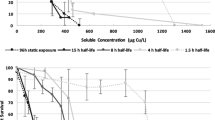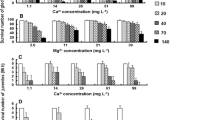Abstract
This paper presents data from original research for use in the development of a marine biotic ligand model and, ultimately, copper criteria for the protection of estuarine and marine organisms and their uses. Ten 48-h static acute (unfed) copper toxicity tests using the euryhaline rotifer Brachionus plicatilis (“L” strain) were performed to assess the effects of salinity, pH, and dissolved organic matter (measured as dissolved organic carbon; DOC) on median lethal dissolved copper concentrations (LC50). Reconstituted and natural saltwater samples were tested at seven salinities (6, 11, 13, 15, 20, 24, and 29 g/L), over a pH range of 6.8–8.6 and a range of dissolved organic carbon of <0.5–4.1 mg C/L. Water chemistry analyses (alkalinity, calcium, chloride, DOC, hardness, magnesium, potassium, sodium, salinity, and temperature) are presented for input parameters to the biotic ligand model. In stepwise multiple regression analysis of experimental results where salinity, pH, and DOC concentrations varied, copper toxicity was significantly related only to the dissolved organic matter content (pH and salinity not statistically retained; α = 0.05). The relationship of the 48-h dissolved copper LC50 values and dissolved organic carbon concentrations was LC50 (μg Cu/L) = 27.1 × DOC (mg C/L)1.25; r 2 = 0.94.



Similar content being viewed by others
References
American Society for the Testing of Materials International (ASTM) (2004) Standard guide for acute toxicity test with the rotifer Brachionus. E 1440-91. Annual book of ASTM standards, vol 11.05. West Conshohocken, PA, pp 830–837
Anderson BS, Hunt JW, Piekarski WJ, Phillips BM, Englund MA, Tjeerdema RS, Goetzl JD (1995) Influence of salinity on copper and azide toxicity to larval topsmelt Atherinops affinis (Ayres). Arch Environ Contam Toxicol 29:366–372
Arnold WR (2005) Effects of dissolved organic carbon on copper toxicity: implications for saltwater copper criteria. Integr Environ Assess Manag 1:34–39
Arnold WR, Cotsifas JS, Corneillie KM (2006) Validation and update of a model used to predict copper toxicity to the marine bivalve Mytilus sp. Environ Toxicol 21:65–70
Arnold WR, Cotsifas JS, Ogle RS, DePalma SGS, Smith DS (2010) A comparison of the copper sensitivity of six invertebrate species in ambient saltwater of varying dissolved organic matter concentrations. Environ Toxicol Chem 29:311–319
Di Toro DM, Allen HE, Bergman HL, Meyer JS, Paquin PR, Santore RC (2001) A biotic ligand model of the acute toxicity of metals. I. Technical basis. Environ Toxicol Chem 20:2383–2396
EPA (U.S. Environmental Protection Agency) (1985) Guidelines for deriving numerical national water quality criteria for the protection of aquatic organisms and their uses. PB85-227049. EPA, Washington, DC
EPA (U.S. Environmental Protection Agency) (1995) Short-term methods for estimating the chronic toxicity of effluents and receiving waters to west coast marine and estuarine organisms. EPA/600/R-95/136. EPA, Washington, DC
EPA (U.S. Environmental Protection Agency) (2003) Notice of availability of draft aquatic life criteria document for copper and request for scientific views. Federal Register December 31, 2003 (68, 250). EPA, Washington, DC, pp 75552–75555
EPA (U.S. Environmental Protection Agency) (2007) Aquatic life ambient freshwater quality criteria—copper 2007 revision. Federal Register February 22, 2007 (72, 35). EPA, Washington, DC, pp 7984–7985
Epp RW, Winston PW (1977) Osmotic regulation in the brackish water rotifer Brachionus plicatilis. J Exp Biol 68:151–156
Grosell M, Blanchard J, Brix KV, Gerdes R (2007) Physiology is pivotal for interactions between salinity and acute copper toxicity to fish and invertebrates. Aquat Toxicol 84:162–172
Hall LW Jr, Anderson RD, Lewis BL, Arnold WR (2008) The influence of salinity and dissolved organic carbon on the toxicity of copper to the estuarine copepod, Eurytemora affinis. Arch Environ Contam Toxicol 54:44–56
Lowe CD, Kemp SJ, Bates AD, Montagnes DJS (2005) Evidence that the rotifer Brachionus plicatilis is not an osmoconformer. Mar Biol 146:923–929
Lubzens E, Rankevich D, Kolodny G, Gibson O, Cohen A, Khayat M (1995) Physiological adaptations in the survival of rotifers (Brachionus plicatilis, O.F. Muller) at low temperatures. Hydrobiologia 313(314):175–183
Nadella SR, Fitzpatrick JL, Franklin N, Bucking C, Smith S, Wood CM (2009) Toxicity of dissolved copper, Zn, Ni, Cd, to developing embryos of the blue mussel (Mytilus trossolus) and the protective effect of dissolved organic carbon. Comp Biochem Phys C 149:340–348
Pagenkopf GK (1983) Gill surface interaction model for trace-metal toxicity to fishes: role of complexation, pH, and water hardness. Environ Sci Technol 17:342–347
Rosen G, Rivera-Duarte I, Kear-Padilla L, Chadwick DB (2005) Use of laboratory toxicity tests with bivalve and echinoderm embryos to evaluate the bioavailability of copper in San Diego Bay, California, USA. Environ Toxicol Chem 24:415–422
Santore RC, Driscoll CT (1995) The CHESS model for calculating chemical equilibria in soils and solutions. In: Loeppert R, Schwab AP, Goldberg S (eds) Chemical equilibrium and reaction models. SSSA Special Publication 42. Soil Science Society of America, American Society of Agronomy, Madison, WI, pp 357–375
Theilacker GH, McMaster MF (1971) Mass culture of the rotifer Brachionus plicatilis and its evaluation as a food for larval anchovies. Mar Biol 10:183–188
Tipping E (1994) WHAM—a chemical equilibrium model and computer code for waters, sediments, and soils incorporating a discrete site/electrostatic model of ion-binding by humic substances. Comput Geosci 20:973–1023
Walker KF (1981) A synopsis of ecological information on the saline lake rotifer Brachionus plicatilis Muller 1786. Hydrobiologia 81:159–167
Acknowledgments
This work was funded by the Copper Development Association, New York. Copper analysis was performed by Columbia Analytical Laboratories, Kelso, Washington.
Author information
Authors and Affiliations
Corresponding author
Rights and permissions
About this article
Cite this article
Arnold, W.R., Diamond, R.L. & Smith, D.S. The Effects of Salinity, pH, and Dissolved Organic Matter on Acute Copper Toxicity to the Rotifer, Brachionus plicatilis (“L” Strain). Arch Environ Contam Toxicol 59, 225–234 (2010). https://doi.org/10.1007/s00244-010-9467-8
Received:
Accepted:
Published:
Issue Date:
DOI: https://doi.org/10.1007/s00244-010-9467-8




